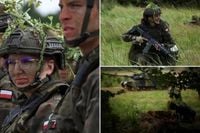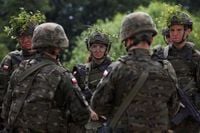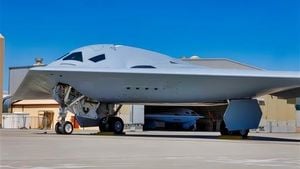Six kilometers from the Russian border, in the small Polish town of Braniewo, the whir of tank engines and the shouts of instructors echo across sandy training grounds. Here, office administrator Agnieszka Jedruszak, her face streaked with camouflage paint, digs a trench under the watchful eyes of military trainers. She’s not alone. Thousands of Poles have flocked to similar voluntary military training sessions in recent months, all driven by a gnawing fear that the war in Ukraine might one day spill over into their own backyards.
“I’d do anything to keep my child safe. And I would definitely want to fight to protect him,” Jedruszak told Reuters, standing in fatigues with her 13-year-old son on her mind. For many Poles, the threat of Russian aggression is not some distant geopolitical chess game—it’s a shadow cast by history and geography, made darker by recent events. The memory of Soviet domination lingers, and the recent downing of Russian drones over Polish territory in early September 2025—the first time a NATO member has used weapons in direct response to Moscow’s war on Ukraine—has only heightened anxieties.
According to Colonel Grzegorz Wawrzynkiewicz, head of Poland’s Central Military Recruitment Centre, more than 20,000 Poles signed up for voluntary military training in the first seven months of 2025 alone. That number is expected to hit 40,000 by year’s end, more than double the 16,000 who joined in 2022. The surge reflects a broader mobilization that’s swept through Poland since Russia’s invasion of Ukraine in 2022. “It’s always somewhere in the back of my mind: the thought that something could happen,” Jedruszak said, echoing a sentiment shared by many participants.
The training itself is held in Braniewo, a site that’s become symbolic of Poland’s military modernization. South Korean K-2 tanks—180 of which were ordered in 2022 as part of a sweeping defense deal—rumble through the forests, a visible sign of Poland’s determination to bolster its defenses. The government has more than doubled defense spending since 2022, raising it from 2.2% of GDP to a staggering 4.7% in 2025. That’s the highest ratio in the 32-nation NATO alliance, outpacing even military heavyweights like Germany, France, and Britain.
The return of Donald Trump to the White House has only added to the sense of urgency. Trump’s skepticism about defending NATO allies has rattled nerves across Europe, prompting Polish Prime Minister Donald Tusk—a child of the Communist era—to urge his fellow leaders to take more responsibility for the continent’s security. “Countries that have no memory of a Russian occupation or Soviet occupation, for them it’s harder to imagine what the thing is you’re fighting for,” Gustav Gressel, a defense policy expert at Vienna’s National Defence Academy, told Reuters.
Poland’s response has been swift and sweeping. In May 2024, construction began on a 400-mile ‘East Shield’ along the borders with Belarus and Russia’s Kaliningrad enclave. The fortifications combine anti-tank barriers, advanced surveillance, and electronic warfare equipment, creating a modern Maginot Line designed to deter or delay any incursion from the east. Military units are being redeployed eastward, and recruitment efforts are focused on local communities—an approach Deputy Defence Minister Pawel Zalewski says will ensure that “people will be working and serving in places where they’ll be defending their own homes.”
The voluntary training program is remarkably flexible. Participants can choose to join the regular army, the part-time Territorial Defence Forces (WOT), or simply remain in reserve. WOT members typically serve in their home regions and can be called up for emergencies ranging from floods to border crises—such as the 2021 standoff with Belarus, when thousands of migrants were funneled toward Poland’s borders. The structure is designed to create a scalable force that can support Poland’s defense strategy in times of need, much like the systems used in Lithuania and Germany.
“When there’s a war or some kind of near-war threat, it’s the most basic things that count: that’s fuel, ammunition and people,” Deputy Defence Minister Cezary Tomczyk explained to Reuters. Technology may be advancing at breakneck speed, but Poland’s leaders insist that human resources remain the backbone of any credible defense. “Every conflict shows one thing: the reserves always win, especially long-term ones,” Colonel Pawel Wronka of Poland’s General Staff observed.
Poland now boasts NATO’s third-largest army, with 216,000 personnel—trailing only the United States and Türkiye. That’s a remarkable leap from 2014, when Poland’s military ranked ninth in the alliance. The government plans to expand its ranks by nearly a third over the next decade, a goal made more challenging by the country’s shrinking and aging population. Still, officials hope that the surge in public engagement and new training initiatives will help overcome demographic headwinds.
In contrast, some of Europe’s traditional military powers are struggling. Germany’s Bundeswehr faces a persistent recruitment crisis, with 20,000 positions unfilled and the army’s current strength at 180,000—well short of the new 260,000 target. Britain’s army, meanwhile, has shrunk to just 71,000 full-time trained soldiers, its smallest size in over three centuries. Even with increased defense spending and modernization drives, both countries face challenges in attracting and retaining new recruits.
Eastern European nations, on the other hand, have been more willing to answer the call. “They are more willing to fight because they can’t just run away,” Gressel noted. The contrast is stark, and it’s reshaping the security landscape across the continent.
Europe’s reliance on the United States remains a sticking point. Despite regional initiatives like SAFE and rising military budgets, a June analysis by the Atlantic Council concluded that NATO still depends heavily on American capabilities—particularly for fighter jets, missiles, and air defense. The war in Ukraine has underscored this dependence, with U.S. technology leading in emerging fields like drones, AI, and satellite networks. Unlike Russia, most European armies lack robust reserve components, making it difficult to sustain heavy losses over extended periods.
In February 2025, Prime Minister Tusk unveiled a new program aimed at preparing 100,000 volunteers for military and civil defense training by 2027. It’s an ambitious goal, but one that officials say is vital for Poland’s long-term security. According to NATO estimates, Russia would need several years to be ready for a full confrontation with the West—a window that Polish leaders are determined to use wisely. “We’re ready to face the kind of threat that is real today. And we’re preparing for the threat that will be real tomorrow,” Zalewski said.
The mood in Poland is a mixture of anxiety, determination, and realism. For Jedruszak and thousands like her, the drills in Braniewo are more than just exercises—they’re a statement of intent. In a region where history’s lessons are never far away, Poles are making it clear that they intend to be ready, come what may.






